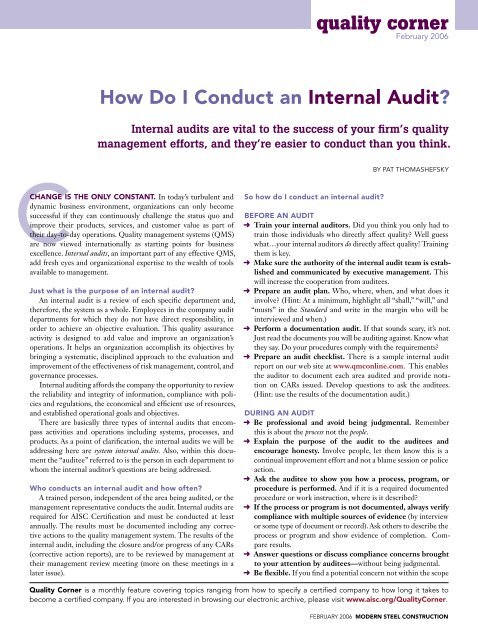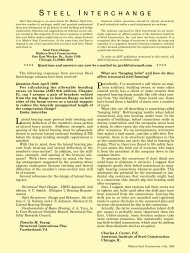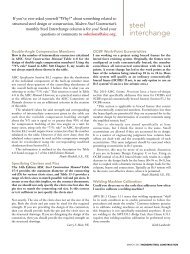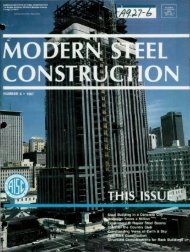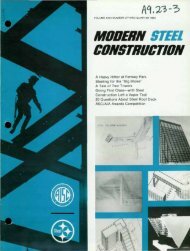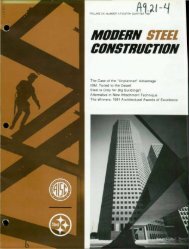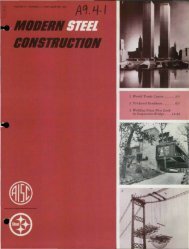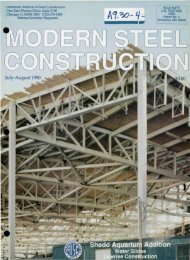How Do I Conduct an Internal Audit? - Modern Steel Construction
How Do I Conduct an Internal Audit? - Modern Steel Construction
How Do I Conduct an Internal Audit? - Modern Steel Construction
You also want an ePaper? Increase the reach of your titles
YUMPU automatically turns print PDFs into web optimized ePapers that Google loves.
CHANGE IS THE ONLY CONSTANT. In today’s turbulent <strong>an</strong>d<br />
dynamic business environment, org<strong>an</strong>izations c<strong>an</strong> only become<br />
successful if they c<strong>an</strong> continuously challenge the status quo <strong>an</strong>d<br />
improve their products, services, <strong>an</strong>d customer value as part of<br />
their day-to-day operations. Quality m<strong>an</strong>agement systems (QMS)<br />
are now viewed internationally as starting points for business<br />
excellence. <strong>Internal</strong> audits, <strong>an</strong> import<strong>an</strong>t part of <strong>an</strong>y effective QMS,<br />
add fresh eyes <strong>an</strong>d org<strong>an</strong>izational expertise to the wealth of tools<br />
available to m<strong>an</strong>agement.<br />
Just what is the purpose of <strong>an</strong> internal audit?<br />
An internal audit is a review of each specific department <strong>an</strong>d,<br />
therefore, the system as a whole. Employees in the comp<strong>an</strong>y audit<br />
departments for which they do not have direct responsibility, in<br />
order to achieve <strong>an</strong> objective evaluation. This quality assur<strong>an</strong>ce<br />
activity is designed to add value <strong>an</strong>d improve <strong>an</strong> org<strong>an</strong>ization’s<br />
operations. It helps <strong>an</strong> org<strong>an</strong>ization accomplish its objectives by<br />
bringing a systematic, disciplined approach to the evaluation <strong>an</strong>d<br />
improvement of the effectiveness of risk m<strong>an</strong>agement, control, <strong>an</strong>d<br />
govern<strong>an</strong>ce processes.<br />
<strong>Internal</strong> auditing affords the comp<strong>an</strong>y the opportunity to review<br />
the reliability <strong>an</strong>d integrity of information, compli<strong>an</strong>ce with policies<br />
<strong>an</strong>d regulations, the economical <strong>an</strong>d efficient use of resources,<br />
<strong>an</strong>d established operational goals <strong>an</strong>d objectives.<br />
There are basically three types of internal audits that encompass<br />
activities <strong>an</strong>d operations including systems, processes, <strong>an</strong>d<br />
products. As a point of clarification, the internal audits we will be<br />
addressing here are system internal audits. Also, within this document<br />
the “auditee” referred to is the person in each department to<br />
whom the internal auditor’s questions are being addressed.<br />
Who conducts <strong>an</strong> internal audit <strong>an</strong>d how often?<br />
A trained person, independent of the area being audited, or the<br />
m<strong>an</strong>agement representative conducts the audit. <strong>Internal</strong> audits are<br />
required for AISC Certification <strong>an</strong>d must be conducted at least<br />
<strong>an</strong>nually. The results must be documented including <strong>an</strong>y corrective<br />
actions to the quality m<strong>an</strong>agement system. The results of the<br />
internal audit, including the closure <strong>an</strong>d/or progress of <strong>an</strong>y CARs<br />
(corrective action reports), are to be reviewed by m<strong>an</strong>agement at<br />
their m<strong>an</strong>agement review meeting (more on these meetings in a<br />
later issue).<br />
quality corner<br />
February 2006<br />
<strong>How</strong> <strong>Do</strong> I <strong>Conduct</strong> <strong>an</strong> <strong>Internal</strong> <strong>Audit</strong>?<br />
<strong>Internal</strong> audits are vital to the success of your firm’s quality<br />
m<strong>an</strong>agement efforts, <strong>an</strong>d they’re easier to conduct th<strong>an</strong> you think.<br />
So how do I conduct <strong>an</strong> internal audit?<br />
BY PAT THOMASHEFSKY<br />
BEFORE AN AUDIT<br />
➜ Train your internal auditors. Did you think you only had to<br />
train those individuals who directly affect quality? Well guess<br />
what…your internal auditors do directly affect quality! Training<br />
them is key.<br />
➜ Make sure the authority of the internal audit team is established<br />
<strong>an</strong>d communicated by executive m<strong>an</strong>agement. This<br />
will increase the cooperation from auditees.<br />
➜ Prepare <strong>an</strong> audit pl<strong>an</strong>. Who, where, when, <strong>an</strong>d what does it<br />
involve? (Hint: At a minimum, highlight all “shall,” “will,” <strong>an</strong>d<br />
“musts” in the St<strong>an</strong>dard <strong>an</strong>d write in the margin who will be<br />
interviewed <strong>an</strong>d when.)<br />
➜ Perform a documentation audit. If that sounds scary, it’s not.<br />
Just read the documents you will be auditing against. Know what<br />
they say. <strong>Do</strong> your procedures comply with the requirements?<br />
➜ Prepare <strong>an</strong> audit checklist. There is a sample internal audit<br />
report on our web site at www.qmconline.com. This enables<br />
the auditor to document each area audited <strong>an</strong>d provide notation<br />
on CARs issued. Develop questions to ask the auditees.<br />
(Hint: use the results of the documentation audit.)<br />
DURING AN AUDIT<br />
➜ Be professional <strong>an</strong>d avoid being judgmental. Remember<br />
this is about the process not the people.<br />
➜ Explain the purpose of the audit to the auditees <strong>an</strong>d<br />
encourage honesty. Involve people, let them know this is a<br />
continual improvement effort <strong>an</strong>d not a blame session or police<br />
action.<br />
➜ Ask the auditee to show you how a process, program, or<br />
procedure is performed. And if it is a required documented<br />
procedure or work instruction, where is it described?<br />
➜ If the process or program is not documented, always verify<br />
compli<strong>an</strong>ce with multiple sources of evidence (by interview<br />
or some type of document or record). Ask others to describe the<br />
process or program <strong>an</strong>d show evidence of completion. Compare<br />
results.<br />
➜ Answer questions or discuss compli<strong>an</strong>ce concerns brought<br />
to your attention by auditees—without being judgmental.<br />
➜ Be flexible. If you find a potential concern not within the scope<br />
Quality Corner is a monthly feature covering topics r<strong>an</strong>ging from how to specify a certified comp<strong>an</strong>y to how long it takes to<br />
become a certified comp<strong>an</strong>y. If you are interested in browsing our electronic archive, please visit www.aisc.org/QualityCorner.<br />
FEBRUARY 2006 MODERN STEEL CONSTRUCTION
<strong>Conduct</strong>ing a <strong>Do</strong>cumentation <strong>Audit</strong><br />
We think of the overall audit process as, “Say what you<br />
do” <strong>an</strong>d “<strong>Do</strong> what you say.” The documentation (i.e. the<br />
quality m<strong>an</strong>ual <strong>an</strong>d procedures) is your opportunity to say<br />
what you do in a m<strong>an</strong>ner detailed enough to help a new<br />
employee step in <strong>an</strong>d run the show—in the event you win the<br />
lotto tomorrow. A documentation<br />
audit is a thorough review necessary<br />
to determine whether the comp<strong>an</strong>y<br />
m<strong>an</strong>ual <strong>an</strong>d procedures are reflective<br />
of the AISC requirements <strong>an</strong>d<br />
especially your business. A documentation<br />
audit c<strong>an</strong> identify omissions<br />
that could impact the quality<br />
of your processes <strong>an</strong>d products now<br />
<strong>an</strong>d in the future.<br />
For the highest degree of effectiveness,<br />
a documentation audit<br />
should be performed in conjunction<br />
with the actual audit. The review<br />
should involve the objective assessment<br />
of whether the documentation<br />
in your comp<strong>an</strong>y’s procedures or<br />
work instructions is representative of<br />
the processes performed. During the<br />
review, collect data relative to documentation<br />
deficiencies identified<br />
<strong>an</strong>d describe what (if <strong>an</strong>ything) was<br />
of the audit, evaluate the potential risks of the problem if left<br />
unaddressed <strong>an</strong>d discuss this with the auditee. Depending upon<br />
time constraints, you may w<strong>an</strong>t to do this after the internal<br />
audit for this area is complete; make a note to address the concern<br />
at that time.<br />
AFTER THE AUDIT<br />
➜ If more th<strong>an</strong> one internal auditor was involved, hold <strong>an</strong><br />
auditors’ meeting to discuss the findings.<br />
➜ Hold a closing meeting with the auditees. This does not<br />
need to be as formal as it may sound.<br />
• First, point out what was done well.<br />
• Second, address the non-conform<strong>an</strong>ces <strong>an</strong>d ensure that the auditees<br />
underst<strong>an</strong>d the non-conform<strong>an</strong>ces <strong>an</strong>d what part of the criteria<br />
was not met.<br />
➜ Issue the CARs in a timely m<strong>an</strong>ner. (Hint: Include areas for<br />
auditees to indicate a pl<strong>an</strong> to prevent reoccurrence.)<br />
➜ Assist those responsible for completing the corrective<br />
actions with setting reasonable deadlines. The corrective<br />
action deadlines may vary depending on the severity of the<br />
noncompli<strong>an</strong>ce.<br />
➜ Be available <strong>an</strong>d willing to help the auditees.<br />
➜ Ask for feedback on how you <strong>an</strong>d your audit team were<br />
perceived. Adjust your approach if necessary.<br />
One Last Tip: Involve People!<br />
Use audits as opportunities to train others. Ask for a volunteer<br />
(who is not <strong>an</strong> auditor) to walk through the audit process with<br />
you as <strong>an</strong> assist<strong>an</strong>t. This will provide others with a better underst<strong>an</strong>ding<br />
of what audits are <strong>an</strong>d why they are necessary. Involving<br />
MODERN STEEL CONSTRUCTION FEBRUARY 2006<br />
A downloadable, printable version of these<br />
documentation audit labels is available online<br />
at www.qmconline.com.<br />
done about the deficiencies.<br />
Collect the results of each record or documentation episode<br />
for which you issued a corrective action report (CAR).<br />
In particular, identify <strong>an</strong>y action the auditee took when the<br />
possible documentation deficiency was pointed out to him/<br />
her. This way you c<strong>an</strong> assess the effectiveness<br />
of your review <strong>an</strong>d monitor<br />
areas where work is still needed. Offering<br />
constructive feedback to the individual<br />
auditee, as well as highlighting the<br />
impact of those findings, is invaluable.<br />
Need help?<br />
QMC has designed a set of color<br />
coded documentation labels intended<br />
to save you time when you conduct a<br />
documentation audit in accord<strong>an</strong>ce with<br />
the Certification St<strong>an</strong>dard for <strong>Steel</strong> Building<br />
Structures. This unique tool c<strong>an</strong> be<br />
downloaded for free from www.qmconline.com<br />
under the “resources” section.<br />
The labels c<strong>an</strong> be printed on st<strong>an</strong>dard<br />
address labels <strong>an</strong>d are used to identify all<br />
of the areas in the Building St<strong>an</strong>dard that<br />
require documentation <strong>an</strong>d specific procedures.<br />
An example of a CAR c<strong>an</strong> also<br />
be found in the “resources” section.<br />
people creates a feeling that everyone is a vital contributor to the<br />
comp<strong>an</strong>y’s goal—compli<strong>an</strong>ce.<br />
An internal audit c<strong>an</strong>not effectively be accomplished sitting<br />
around a boardroom table. The initial doc audit may be done alone<br />
at a desk, but you have to get out <strong>an</strong>d talk to those performing the<br />
processes in order to get a reliable “snapshot” of your system.<br />
Pat Thomashefsky is Lead <strong>Audit</strong>or for Quality M<strong>an</strong>agement Comp<strong>an</strong>y,<br />
LLC.<br />
Questions? Call us at 312.670.7520 or e-mail certinfo@qmconline.<br />
com. Visit www.qmconline.com <strong>an</strong>d click on FAQs to see what<br />
questions others are asking.


